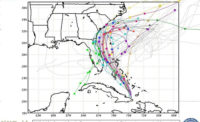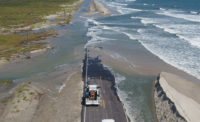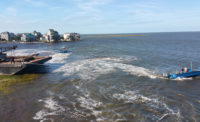Along the U.S. coast, when a hurricane or tropical storm is about to hit, contractors on active job sites know they must complete a long checklist of tasks: take down or lower cranes; secure exterior building openings, materials and construction equipment; and remove debris from sites. But due to COVID-19, there’s another big item that’s been added to the checklist: keep workers safe from the new coronavirus through proper social distancing and personal protective equipment. And as the nation faces a hurricane season that is forecast to be above normal in storm frequency and intensity, and possibly hit earlier—Tropical Storm Bertha struck South Carolina’s coast May 27—contractors must also prepare to return to a site and restore it under those same viral conditions.
The 2020 hurricane season, which officially began June 1, “brings unique, parallel challenges to COVID-19 and tropical storm preparedness,” says Rachael Farr, spokeswoman for Birmingham, Ala.-based Robins & Morton. “The pandemic’s most significant impact on hurricane preparedness will remain centered on personal actions due to limited supplies, social distancing, closed shelters and a need for more advanced planning.”
Some contractors say the planning required to battle the coronavirus has put them ahead of the curve in preparing for hurricane season this year, which researchers at Colorado State University predict will result in 16 named storms, with four of major hurricane strength.
For Landis Construction in New Orleans, the shutdown served as a dry run for employees working remotely to support field teams. “In terms of those kinds of logistics, I actually feel like we’re more prepared than we’ve ever been for a storm season,” says CEO Anne Teague Landis. “It’s created an opportunity to prepare at a whole different level than we typically have.”
Integrated Approach
An integrated approach in preparing for both threats is vital, says Melinda Gentile, a partner and construction law specialist in the Miami office of Peckar & Abramson. A major weather event could exacerbate the virus’s already demonstrated disruptive power on material and staffing resources, she says.
“Contractors can’t look to one plan for weather events and another one for COVID-19,” Gentile says.
For example, operating with a smaller workforce due to labor shortages or to comply with social distancing measures will also mean fewer people available to secure a site ahead of an approaching storm. Because supply chains for construction materials are already under
virus-related stress, a post-storm demand surge could make some scarce materials costlier or harder to secure, Gentile notes.
Some Southeast contractors have adapted their hurricane mobilization and demobilization strategies to mesh with a COVID-19 environment. Cory Hrynyk, operations manager for PCL Construction’s Orlando, Fla., office, says the firm is “definitely assuming longer timelines” to prepare jobsites for impending hurricanes while also complying with social distancing requirements.
“We’re looking at multiple shifts with alternate start times so that we can accomplish the same amount of preparatory work with fewer people,” he says. For tornadoes and other severe weather events that can arise with little warning, “we’ve implemented additional shelter areas at jobsites, instead of a single muster area, to maintain social distancing.
“COVID-19, as unfortunate as it is, has increased our ability and heightened our awareness to plan,” Hrynyk says, adding that an unexpected dividend has been a decrease in jobsite injury rates. “Employees have increased awareness of utilizing PPE and are being more careful on the jobsite,” he says. “It’s reinforcing a whole host of things that we teach, plan for and expect in our culture.”
Reassessment
COVID-19 gave Landis a rare opportunity to assess its jobsite priorities and needs. In early April, the firm put construction on hold for two weeks at all of its sites as a precaution, even though there were no known infections among workers. Its major projects include the $50-million Ernest N. Morial Convention Center Linear Park and the $31-million City Square apartment complex, both in New Orleans. “Rather than reminding ourselves on paper what needs to be done in preparation for a storm, we physically went through that process,” Landis says.
Jobsite security was one concern that emerged during the shutdown as the firm saw a need to better secure one of its unmanned sites. “We saw more people coming onto the jobsite for shelter, or more nefarious reasons, so we had to increase our security from nighttime to 24-hour security to ward that off,” she says.
New Orleans contractor Palmisano LLC also used its COVID-19 response to get things ready for storm season. Because of social distancing, the firm has been relying more on offsite prefabrication to reduce work needed at jobsites. “This has the added benefit of reducing unnecessary inventory at the jobsite, which reduces necessary hurricane preparations,” says President Wes Palmisano.
With cities and states implementing different rules for reopening, firms that operate across state lines are having to tailor their own plans to accommodate the various rules and regulations, says Dave Beck, managing partner at Metairie, La.-based Audubon Cos., which provides engineering services throughout the region for the oil and gas industry. “This has put pressure on our [health, safety and environment] staff to continually be up to date on regulation changes and create multiple safety plans, negating any benefits or streamlining that companies have worked hard to implement,” Beck says.
In Texas, new building codes to help residential and commercial structures withstand high winds are set to go into effect Sept. 1. But training workers on how to implement these new provisions could be more of a challenge this year, says Ned Munoz, vice president of legal affairs for the Texas Association of Builders, which worked with insurance regulators to develop the new codes. “With social distancing, that’s going to be a little different and certainly not as easy to do,” he says.
Contracts and Insurance
Gentile also cautions that while many construction contracts may include provisions for hurricane-related cost and schedule effects, not all clearly deal with pandemic issues.
“It’s going to be difficult to unfold where an impact from a COVID-19 issue arises and where one from a weather-related issue arises, and properly apply the costs,” she says.
Joe Hudgins, vice president of technical research and government relations for the Independent Insurance Agents of Virginia, says while demand surge has worked its way into most construction insurance policy models, deadlines remain central.
“If you’ve agreed to build something by November 1, you have to keep supplies on hand unless you can show the hurricane had an effect on their availability,” he says. As for business interruption coverage, “you absolutely should review your policy to see what is and isn’t covered.”
Contractors, by nature, are well-versed in risk, and hurricane prep is nothing new for coastal firms, says David Halveston, president and CEO of the Pelican Chapter of the Associated Builders and Contractors in Baton Rouge, La. “Contractors evaluate and mitigate risks every day on the jobsite, whether it’s during a pandemic or hurricane season or any other unforeseen crisis.”







Post a comment to this article
Report Abusive Comment